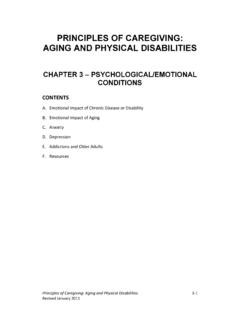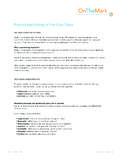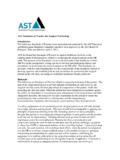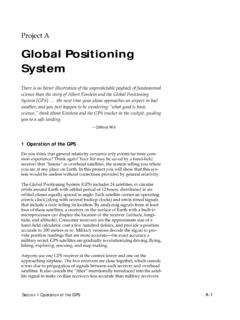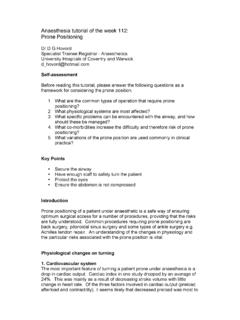Transcription of CHAPTER 5 – TRANSFERS AND POSITIONING
1 Principles of Caregiving: Aging and Physical Disabilities 5-1 Revised January 2011 PRINCIPLES OF CAREGIVING: AGING AND PHYSICAL DISABILITIES CHAPTER 5 TRANSFERS AND POSITIONING CONTENTS A. Principles of Body Mechanics for Back Safety B. Transferring 1. Basic Principles 2. Gait Belt 3. Transferring Out of Bed to a Standing Position 4. transfer from Wheelchair to Chair 5. Mechanical Lift 6. transfer or Slide Board C. Ambulation (Walking) D. Turning and POSITIONING 1. Preventing Pressure Sores 2. Preventing Contractures 3. POSITIONING in Bed 4. POSITIONING in Wheelchair or Chair 5. Range of Motion (ROM) Exercises E. Assistive Devices 1. Canes 2. Walkers 3. Wheelchairs CHAPTER 5 TRANSFERS and POSITIONING Principles of Caregiving: Aging and Physical Disabilities 5-2 Revised January 2011 OBJECTIVES 1.
2 Identify and demonstrate good body mechanics related to transferring and walking with an individual. 2. Explain the importance of repositioning and list techniques for preventing skin damage and pressure ulcers. 3. Describe common assistive devices and techniques for using them safely. 4. Demonstrate the safe use of selected assistive devices. SKILLS Assistance with ambulation Application and use of gait belt Technique for POSITIONING a person in bed Technique for POSITIONING a person in a wheelchair transfer from chair to wheelchair transfer out of bed KEY TERMS Ambulation Mechanical LiftBody mechanics Range of motion (ROM) exercises Center of gravity TransferContractures transfer boardGait belt ( transfer belt) WalkerLeverage Wheelchair CHAPTER 5 TRANSFERS and POSITIONING Principles of Caregiving.
3 Aging and Physical Disabilities 5-3 Revised January 2011 ! REMEMBER! Safe TRANSFERS and following proper procedures will protect your health and safety and the people you care for. Assistive devices and equipment can help with ADLs but they need to be used correctly. If you do not use equipment correctly, you and the person you care for may be at risk. This CHAPTER covers proper procedures for TRANSFERS and POSITIONING and use of assistive devices and equipment. However, there are many different types of equipment being used by our clients. A. PRINCIPLES OF BODY MECHANICS FOR BACK SAFETY Using correct body mechanics is an important part of a DCW's job because: The individual with a disability depends on the DCW for hands-on assistance.
4 If the DCW does not take care of his/her back with correct body mechanics, the DCW will not be able to provide that assistance. Not using correct body mechanics puts the safety of the client and DCW at risk. Some injuries cause permanent disabilities. Just as lifting, pushing, and pulling loads can damage your back, so can bending or reaching while working in an individual s home. As a DCW, you may have witnessed firsthand the pain and misery a back injury can cause. The good news is that you can learn some simple ways to reduce the risk of injury. Body mechanics principles Proper footwear: DCWs should always wear proper footwear. Wear closed, non-slip shoes. Center of gravity over base of support: Be aware of center of gravity over base of support in working with a client.
5 Usually a person s center of gravity is right behind a person s navel (belly button). A good base of support is being in a standing position where the feet are slightly apart and knees slightly bent. Principles of body leverage: Using leg and arm muscles is important, as is applying body leverage. Mirror posture of the client. Use body as a whole and not just one part. ! Call your supervisor to get more training or clarification on any transfer skill or use of equipment. CHAPTER 5 TRANSFERS and POSITIONING Principles of Caregiving: Aging and Physical Disabilities 5-4 Revised January 2011 B. TRANSFERRING 1. Basic Principles A move as basic as getting in and out of a chair can be difficult for an individual with a disability, depending on his/her age, flexibility, and strength.
6 Techniques for assisting an individual with TRANSFERS can vary. Some persons require a high level of assistance (maximum assist). The DCW will have to use assistive devices, such as a gait belt or a mechanical lift. Other persons will need less assistance (minimum assist), making the devices optional. The height and stability of the chair or other sitting surface also plays a role in the successful transfer . A slightly raised seat is preferable to one that is low or deep. A chair that has armrests is also preferable. Levels of assistance in TRANSFERS Maximum assist Mechanical lift. Gait belt with person who is 50% or less weight bearing. Moderate assist Gait belt with person who is 50% or more weight bearing. Verbal cues with moderate physical assist.
7 Minimum assist Gait belt optional. Hands on with person who is 85 - 90% weight bearing. Verbally and physically guiding the client. Stand by assist (this is to ensure safety). General guidelines for assistance with TRANSFERS While procedures can vary for certain kinds of TRANSFERS , there are general guidelines that apply when assisting with any transfer : Explain each step of the transfer and allow the person to complete it slowly. Verbally instruct the client on the sequence of the transfer ( Move to the front of the chair, etc.). When assisting in the transfer of a person do not grab, pull or lift by the person s arm joints (elbows, shoulders, wrists) as this can cause a joint injury. Know your limits! Don t transfer anyone heavier than what you can handle.
8 If the person is unable to stand or is too weak to stand, the DCW should use a mechanical lift for TRANSFERS . If this is not in the service plan or you do not know how to use a mechanical lift, ask your supervisor for instructions on what to do. CHAPTER 5 TRANSFERS and POSITIONING Principles of Caregiving: Aging and Physical Disabilities 5-5 Revised January 2011 ! At no time should the client put her or his hands around the DCW s neck during a transfer . 2. Gait Belt A gait belt, sometimes called transfer belt, provides the DCW with secure points to hold onto while assisting clients in walking and transfer activities. Before using, ensure the client can safely wear a gait belt.
9 You may not be able to use one if the person: Has had recent surgery or incisions (within the last 6-8 weeks) in the abdominal and back areas. Has an ostomy (for example, a colostomy), G-tube, hernias, severe COPD, post-surgical incisions, monitoring equipment, tubes or lines that could be interfered with by the pressure. Is pregnant. Applying a gait belt to a pregnant woman could cause injury to the unborn child. If it is determined the client cannot safely use a gait belt, the DCW should contact the supervisor for instruction on agency specific policy and procedures. Procedure: Use of Gait Belt Supplies Gait belt (with metal teeth or quick release buckle) Description of procedure 1. Tell the person what you are going to do. 2. Position the person to make application of the belt easier.
10 The person needs to move forward and sit on the edge of the chair. 3. Place the gait belt around the client s waist, above the pelvic bone and below the rib cage. Always place the gait belt on top of clothing, and for females make sure breast tissue is above the belt. 4. Pass the metal tip of the belt end through the teeth of the buckle first and then through the other side of the buckle. 5. Adjust it so it is snug, but not uncomfortable for the client. You should be able to slip your open flat hand between the belt and the client. CHAPTER 5 TRANSFERS and POSITIONING Principles of Caregiving: Aging and Physical Disabilities 5-6 Revised January 2011 6.



